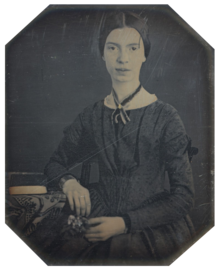
Back Emily Dickinson AN إيميلي ديكنسون Arabic ايميلى ديكنسون ARZ Emily Dickinson AST Emily Dickinson AVK Emili Dikinson Azerbaijani امیلی دیکنسون AZB Эмілі Дзікінсан Byelorussian Эмілі Дыкінсан BE-X-OLD Емили Дикинсън Bulgarian
Emily Dickinson | |
|---|---|
 Daguerreotype taken at Mount Holyoke, December 1846 or early 1847; the only authenticated portrait of Dickinson after early childhood[1] | |
| Born | December 10, 1830 Amherst, Massachusetts, U.S. |
| Died | May 15, 1886 (aged 55) Amherst, Massachusetts, U.S. |
| Resting place | Amherst West Cemetery |
| Occupation | Poet |
| Alma mater | Mount Holyoke Female Seminary |
| Notable works | List of poems |
| Parents | |
| Relatives |
|
Emily Elizabeth Dickinson (December 10, 1830 – May 15, 1886) was an American poet. Little-known during her life, she has since been regarded as one of the most important figures in American poetry.[2] Dickinson was born in Amherst, Massachusetts, into a prominent family with strong ties to its community. After studying at the Amherst Academy for seven years in her youth, she briefly attended the Mount Holyoke Female Seminary before returning to her family's home in Amherst. Evidence suggests that Dickinson lived much of her life in isolation. Considered an eccentric by locals, she developed a penchant for white clothing and was known for her reluctance to greet guests or, later in life, even to leave her bedroom. Dickinson never married, and most of her friendships were based entirely upon correspondence.[3]
Although Dickinson was a prolific writer, her only publications during her lifetime were 10 of her nearly 1,800 poems and one letter.[4] The poems published then were usually edited significantly to fit conventional poetic rules. Her poems were unique for her era; they contain short lines, typically lack titles, and often use slant rhyme as well as unconventional capitalization and punctuation.[5] Many of her poems deal with themes of death and immortality (two recurring topics in letters to her friends), aesthetics, society, nature, and spirituality.[6]
Although Dickinson's acquaintances were most likely aware of her writing, it was not until after she died in 1886—when Lavinia, Dickinson's younger sister, discovered her cache of poems—that her work became public. Her first published collection of poetry was made in 1890 by her personal acquaintances Thomas Wentworth Higginson and Mabel Loomis Todd, though they heavily edited the content. A complete collection of her poetry first became available in 1955 when scholar Thomas H. Johnson published The Poems of Emily Dickinson.[7] In 1998, The New York Times reported on a study in which infrared technology revealed that much of Dickinson's work had been deliberately censored to exclude the name "Susan".[8] At least eleven of Dickinson's poems were dedicated to her sister-in-law Susan Huntington Gilbert Dickinson, and all the dedications were later obliterated, presumably by Todd.[8] This censorship serves to obscure the nature of Emily and Susan's relationship, which many scholars have interpreted as romantic.[9][10][11]
- ^ D'Arienzo (2006); the original is held by Amherst College Archives and Special Collections
- ^ "Emily Dickinson". Poetry Foundation. Retrieved September 5, 2020.
- ^ "Emily Dickinson". Biography.com. February 27, 2018. Archived from the original on March 21, 2022. Retrieved August 25, 2018.
- ^ "The Emily Dickinson Museum indicates only one letter and ten poems were published before her death". Emilydickinsonmuseum.org. Archived from the original on August 7, 2018. Retrieved August 25, 2018.
- ^ McNeil (1986), 2.
- ^ "About Emily Dickinson's Poems: Death, Immortality, and Religion". www.cliffsnotes.com. July 4, 2020. Archived from the original on May 12, 2021. Retrieved July 4, 2020.
- ^ The Poems of Emily Dickinson—Emily Dickinson, Thomas H. Johnson. Belknap Press. December 1955. ISBN 978-0-674-67600-8. Archived from the original on November 6, 2021. Retrieved March 21, 2022.
- ^ a b Weiss, Philip (November 29, 1998). "Beethoven's Hair Tells All!". The New York Times. Archived from the original on March 26, 2020. Retrieved March 21, 2022.
- ^ Cite error: The named reference
:1was invoked but never defined (see the help page). - ^ Cite error: The named reference
:2was invoked but never defined (see the help page). - ^ Dickinson, Emily (1998). Ellen Louise Hart; Martha Nell Smith (eds.). Open me carefully: Emily Dickinson's intimate letters to Susan Huntington Dickinson. Ashfield, MA: Paris Press. ISBN 0-9638183-6-8. OCLC 39746998.
© MMXXIII Rich X Search. We shall prevail. All rights reserved. Rich X Search